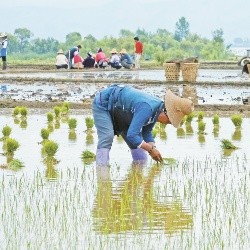Adverse weather in major countries Asian rice suppliersincluding the biggest exporter, India, threatens to cut production of the world’s most important food and stoke food inflation that is already near record highs.
Rice has resisted the upward trend in food prices thanks to bountiful harvests and large inventories of exporters during the last two years, despite the fact that the Covid-19, supply interruptions and, more recently, the conflict between Russia and Ukraine made other cereals more expensive.
But the inclement weather in the exporting countries of Asia, which account for about 90% of production world rice, are likely to change the trajectory of prices, according to traders and analysts.
“There is upside potential for rice prices with the possibility of production being reduced in major exporting countries,” said Phin Ziebell, agribusiness economist at National Australia Bank.
“A rise in rice prices would add to already significant food affordability problems in some parts of the developing world,” Ziebell said.
Irregular rains in the grain belt of India, the heat wave in chinathe floods in bangladesh and declining quality in Vietnam could dampen yields in four of the world’s top five rice producers, farmers, traders and analysts told Reuters.
“Rice has remained affordable despite overall food prices hitting records earlier this year,” said Food and Agriculture Organization economist Shirley Mustafa.
“We are now seeing weather-related headwinds in some key rice producing countries such as India, China and Bangladesh which could lead to lower production if conditions do not improve in the coming weeks,” Mustafa added.
safe fall
India’s major rice-producing states, Bihar, Jharkhand, West Bengal and Uttar Pradesh, have had monsoon rainfall deficits of up to 45% so far this season, according to data from the state weather department.
The lack of water has caused, in part, a 13% decrease in rice planting this year, which could mean a drop in output of 10 million tonnes, or about 8%, from last year, according to BV Krishna Rao, president of the Indian Rice Exporters Association.
Rice acreage has also decreased as some farmers have switched to pulses and oilseeds, Rao said.
Rice planted in summer in the India accounts for more than 85% of its production annually, which reached the record figure of 129.66 million tons in the agricultural campaign until June 2022.
“A drop in output is certain, but the big question is how the government will react,” said a Mumbai-based trader for a global trading firm.
Stocks of paddy and milled rice in India as of July 1 stood at 55 million tonnes, against the target of 13.54 million tonnes.
This has kept rice prices down in the past year, coupled with India’s record shipment of 21.5 million tonnes in 2021, more than the total of the world’s other four largest exporters: Thailand, Vietnam, Pakistan and USA.
“But the government is hyper-sensitive to prices. A small rise could lead it to impose export restrictions,” the trader said.
In Vietnam, rains during harvest have affected grain quality.
“I’ve never seen it rain so much during harvest. It’s just abnormal,” said Tran Cong Dang, a 50-year-old farmer from Bac Lieu province in the Mekong Delta.
“In just ten days, the total rainfall measured is equal to that of the entire previous month,” said Dang, who estimated a 70% production loss in his 2-hectare paddy field due to flooding.
Imports and prices
China, the world’s largest rice consumer and importer, has suffered yield losses from extreme heat in rice-growing areas and imports are expected to rise to a record 6 million tonnes in 2022/23, according to the United States Department of Agriculture.
A year ago, China imported 5.9 million tons.
The world’s third largest consumer, Bangladesh, is also expected to import more rice following flood damage in its main producing regions, according to traders.
Analysts and government agencies, which often don’t release production data until later in the year, have yet to estimate the full extent of the shortage outside of India.
But the repercussions of unfavorable weather for the harvest are already being seen in the slight rise in export prices from India and Thailand this week.
“Rice prices are already near the bottom and we see the market rising from current levels,” said a trader who works in Singapore for one of the world’s largest rice brokers. “Demand is picking up with buyers like the Philippines and others from Africa looking to book cargoes.”








